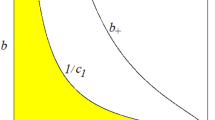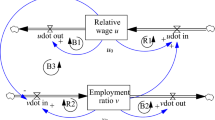Abstract
Capital investment requires a gestation lag for being productive. This time-to-build feature can lead to an autonomous system of mixed-type functional differential equations (FDEs), causing aggregate fluctuations for a deterministic economy. We present a continuation method to solve a system of mixed FDEs by solving a sequence of boundary value problems for systems of ordinary differential equations (ODEs). Unlike other iteration techniques, this method can avoid the need to predetermine both forward-looking and backward-looking difference terms. The strategy is to form a homotopy that can deform a simpler ODE system into a target FDE system, while treating the deformation process as a sequence of ODEs. We can thereby compute oscillatory cycles for a time-to-build economy while it is in transition to the steady state.




Similar content being viewed by others
Change history
20 June 2017
An erratum to this article has been published.
Notes
An FDE can take the general form, \(u'(t)= f(u(t),u(t-\tau ),u(t+\tau ))\), where time t is an independent variable, \(\tau >0\) is a constant span (or retardation), u(t) is an unknown function, and f(.) is a functional. It is of mixed-type if both delays and advances [\(u(t-\tau )\), \(u(t+\tau )\)] are present. It is a delay (advance) differential equation if the advance (delay) term is absent. If \(u'(t-\tau )\) enters as an argument, then \(u'(t)= f(u(t),u(t-\tau ),u(t+\tau ), u'(t-\tau ))\) is of neutral-type. See Bellman and Cooke (1963).
In fact, Rustichini (1989) has shown that an optimal growth model can yield a mixed-type FDE system. This earlier work has a focus on the existence of a Hopf bifurcation in the model economy.
Mixed-type FDEs represent a complicated mathematical object. Among other things, a linear mixed-type FDE has a transcendental characteristic equation featuring infinitely many characteristic roots with positive real parts and infinitely many with negative real parts; see Ford and Lumb (2009).
See Footnote 1 for the definitions of FDEs of various types. Recently, scholars incorporate time-to-build in endogenous growth models, yet their autonomous FDE systems are not of mixed type. Both Bambi (2008) and Bambi et al. (2012) develop a time-to-build AK model and obtain an autonomous system of one advance differential equation. Bambi et al. (2014) embed delayed adoption of new varieties of intermediate goods into an R&D-based growth model, yielding a two-dimensional autonomous system of DDEs.
The seven-dimensional FDE system of Lin and Shampine (2016) can also be solve with our method.
The Hamiltonian is also subject to the familiar transversality condition, \(\lim _{t\rightarrow \infty }\lambda (t)k(t)=0\).
Equation (7) represent a class of nonlinear autonomous systems of mixed FDEs with a constant backward and forward delay \(\tau >0\). For this general class to exactly match the system (5)–(6), the delay vector \(\varvec{u}(t-\tau )\) must reduce to a delay scalar \(k(t-\tau )\), and so must the advance vector \(\varvec{u}(t+\tau )\) to an advance scalar \(c(t+\tau )\). But note that Eqs. (7) do not include FDEs with state-dependent delays or FDEs of neutral type; see Bellman and Cooke (1963), Hale (1977), and Footnote 1.
The familiar method of steps is to solve the initial value problem (IVP) for systems of DDEs by treating DDEs as ODEs in a stepwise manner. This method was firstly developed by Bellman (1961) for DDEs with constant delays, and later by Bellman and Cooke (1965) for variable delays. Standard solvers for DDEs include Matlab’s dde23 and Python’s pydelay.dde23, among other things.
Note that the FDE system in Lin and Shampine (2016) is seven-dimensional, resulting from finite-length patents rather than time-to-build capital. It takes the form: \(\dot{\varvec{u}}(t)=\varvec{F}(\varvec{u}(t), \varvec{u}(t-\tau ), \varvec{u}(t+\tau ), \dot{\varvec{u}}(t-\tau ) )\). This system is more general than (7) due to the delayed time derivative entering \(\varvec{F}(.)\). It is of both mixed type and neutral type.
In Lin and Shampine (2016), the linear interpolation works as follows: Let \(\bar{\varvec{u}}_0\) be the initial steady state and \(\bar{\varvec{u}}\) be the new steady state. Then \(slope=(\bar{\varvec{u}}-\bar{\varvec{u}}_0)/(\bar{t}-t_0)\), \(\varvec{u}(t+\tau )=(t+\tau ) \times slope\), and \(\varvec{u}(t-\tau )=(t-\tau ) \times slope\) for \(t_0<t-\tau<t+\tau <\bar{t}\), where \(t_0=0\) is the present time and as note earlier, \(\bar{t}\) is large enough for the economy get sufficiently close to the steady state.
The idea of homotopy (continuation) methods is to formalize the mechanism of deforming a simple problem into a difficult one. It may generate a globally convergent sequence for finding roots of nonlinear algebraic equations; see Judd (1998, pp. 179–187).
For the other parameters, the level of total factor productivity is normalized to unity (\(A=1\)), the capital share is set at \(\alpha =0.30\), the rate of time preference is set at \(\rho =0.05\), and the elasticity of intertemporal substitution is set at \(\frac{1}{\sigma }=\frac{2}{3}\).
For our exercises, the error tolerances can be reduced to as small as \(10^{(-10)}\).
Recall that the social planner equilibrium coincides with the decentralized one for the time-to-build growth model.
In Table 3, the “continuation” column refers to the homotopic continuation algorithm presented in this paper; the “BVP sequecnce” column is for the relaxation algorithm based on Lin and Shampine (2016), which solves FDEs as a sequence of BVPs for systems of ODEs; and the “IVP sequence” column corresponds to the shooting algorithm based on Collard et al. (2008), which solves FDEs as a sequence of IVPs for systems of ODEs. For the continuation method, the number of iterations is the sum of those iterations corresponding to the row of \(\tau =2\) and the row of \(\tau =20\) of Table 2, respectively. Certainly, the number of such iterations is subject to how dense the continuation mesh (p) is. For the “IVP sequence” method, the number of iterations is directly adapted from Collard et al. (2008).
For instance, from my experiments, the “IVP-sequence” method fails to solve a seven-dimensional FDE system of mixed type for an R&D-based growth model derived in Lin and Shampine (2016), in contrast to the “continuation” and “BVP-sequence” methods.
References
Asea, P. K., & Zak, P. J. (1999). Time-to-build and cycles. Journal of Economic Dynamics and Control, 23, 1155–1175.
Asl, F. M., & Ulsoy, A. G. (2003). Analysis of a system of linear delay differential equations. Journal of Dynamic Systems, Measurement, and Control, 125, 215–223.
Bambi, M. (2008). Endogenous growth and time-to-build: The AK case. Journal of Economic Dynamics and Control, 32, 1015–1040.
Bambi, M., Fabbri, G., & Gozzi, F. (2012). Optimal policy and consumption smoothing effects in the time-to-build AK model. Economic Theory, 50, 635–669.
Bambi, M., Gozzi, F., & Licandroc, O. (2014). Endogenous growth and wave-like business fluctuations. Journal of Economic Theory, 154, 68–111.
Bellman, R. (1961). On the computational solution of differential-difference equations. Journal of Mathematical Analysis and Applications, 2(1), 108–110.
Bellman, R., & Cooke, K. L. (1963). Differential-difference equations. New York: Academic Press.
Bellman, R., & Cooke, K. L. (1965). On the computational solution of a class of functional differential equations. Journal of Mathematical Analysis and Applications, 12(3), 495–500.
Collard, F., Licandro, O., & Puch, L. A. (2008). The short-run dynamics of optimal growth model with delays. Annales d’Economie et de Statistique, 90, 127–143.
Ford, N. J., & Lumb, P. M. (2009). Mixed-type functional differential equations: A numerical approach. Journal of Computational and Applied Mathematics, 229, 471–479.
Futagami, K., & Iwaisako, T. (2007). Dynamic analysis of patent policy in an endogenous growth model. Journal of Economic Theory, 132, 306–334.
Gray, M. R., & Turnovsky, S. J. (1979). Expectational consistency, informational lags, and the formulation of expectations in continuous time models. Econometrica, 47, 1457–1474.
Hale, J. K. (1977). Theory of functional differential equations. New York: Springer.
Judd, K. L. (1985). On the performance of patents. Econometrica: Journal of the Econometric Society, 53, 567–585.
Judd, K. I. (1998). Numerical methods in economics. Cambridge: MIT.
Kalecki, M. (1935). A macrodynamic theory of business cycles. Econometrica: Journal of the Econometric Society, 3, 327–344.
Kolmanovskii, V., & Myshkis, A. (1998). Introduction to the theory and applications of functional differential equations. Dordrecht: Kluwer.
Kydland, F. E., & Prescott, E. C. (1982). Time to build and aggregate fluctuations. Econometrica: Journal of the Econometric Society, 50, 1345–1370.
Lin, H. C., & Shampine, L. F. (2016). R&D-based calibrated growth models with finite-length patents: A novel relaxation algorithm for solving an autonomous FDE system of mixed type. Computational Economics, 1–36. doi:10.1007/s10614-016-9597-9.
Rustichini, A. (1989). Hopf bifurcation for functional differential equations of mixed type. Journal of Dynamics and Differential Equations, 1, 145–177.
Acknowledgements
The earlier draft of this article was presented at the 22nd International Conference Computing in Economics and Finance (CEF 2016), Bordeaux, France, June 26-28, 2016. The author wishes to thank some of the conference participants, Benjamin Russo and L.F. Shampine for valuable conversations and comments. In particular, several valuable suggestions and comments from two anonymous referees are greatly appreciated.
Author information
Authors and Affiliations
Corresponding author
Additional information
An erratum to this article is available at https://doi.org/10.1007/s10614-017-9710-8.
Appendix: Pseudo Code for Continuation Method
Appendix: Pseudo Code for Continuation Method

Rights and permissions
About this article
Cite this article
Lin, H.C. Computing Transitional Cycles for a Deterministic Time-to-Build Growth Model. Comput Econ 51, 677–696 (2018). https://doi.org/10.1007/s10614-016-9633-9
Accepted:
Published:
Issue Date:
DOI: https://doi.org/10.1007/s10614-016-9633-9
Keywords
- Time-to-build
- Cycles
- Transition dynamics
- Continuation method
- Homotopy
- Deformation process
- Functional differential equations




